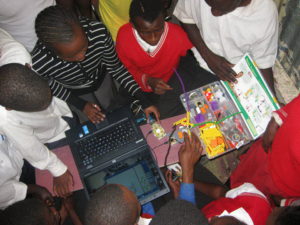Commentary on Mindstorms by Seymour Papert: Children, Computers and Powerful Ideas
“Certain uses of very powerful computational technology and computational ideas can provide children with new possibilities for learning, thinking, and growing emotionally as well as cognitively.”
Reading Papert’s Mindstorm shed light on several parallels between the learning environment in 1980 when the book was published, to changes currently taking place in the educational system in Kenya as well as the fruition of Papert’s vision disruptive learning.
Uhuru Kenyatta, the current president of the republic of Kenya, in 2013 announced that his government would provide one laptop for each children entering standard one in primary school (the equivalent of first grade). This ties in closely with the concepts that the uptake of integrating computers in education will often be politically influenced, and through bureaucratic channels. What this means is that they will be a shift in the learning environment for children in the public education system who, as Papert described, would provide the unique environment for children to program the computer as opposed to the computer programming the children. The ripple effect of providing these tools being that shifts to ‘thinking about thinking turns the child into an epistemologists’ which leads to thinking of children as active builders for their own intellectual structures.
When the FabLab Robotics Outreach Program (FROP) team first embarked on its project in Dagoretti slum in 2009, we set up to disrupt learning by providing an open learning environment. Using both computer software (Picoblocks inspired by LOGO) and computer hardware (LEGO complemented with sensors and motors), what we indirectly were doing was creating a mathland where it was both interesting and natural to learn about math and science. The experiences of the children were best captured as Papert put it:
“The child programs the computer and in doing so, both acquires a sense of mastery over the piece of the most moderns and powerful technology and establishes an intimate contact with some of the deepest ideas from science, from mathematics and from the art of intellectual model building.” Minstorms p.5
By creating Mathlands where it is possible to understand math from the environment in which the child works, emphasizes by his own personal example being this interaction with gears and the influence this had on this interest in math and its understanding. These unique platforms are not only user friendly, they are also powerful learning environments.
Papert does not rule out the need for teachers or imply that the world would be better without schools. What the modern education system needs to incorporate are modern learning technologies and theories, cross curricular applications, and application of various skills in a creative way. There needs to be shift from instructionism which implies passive learning to Piaget’s constructionism that allows children to use the materials they find about them to develop salient learning models. This leads to intellectual development in children outside traditional learning conditions through open ended discovery which developing the culture of ‘thinking about thinking’ in children.